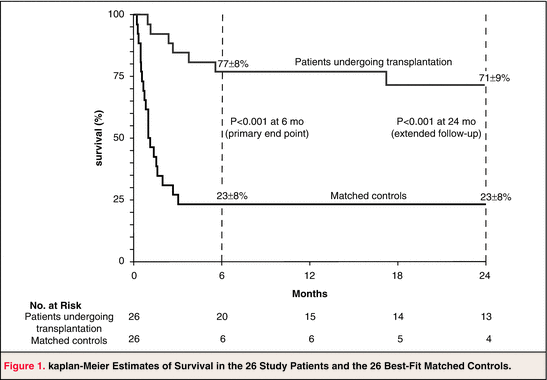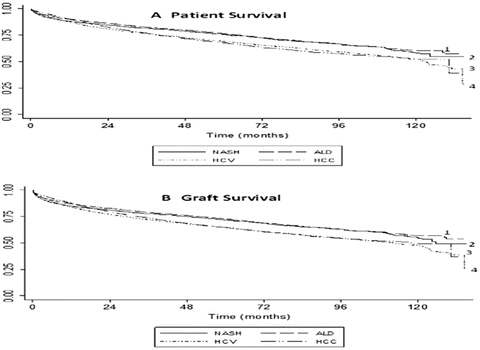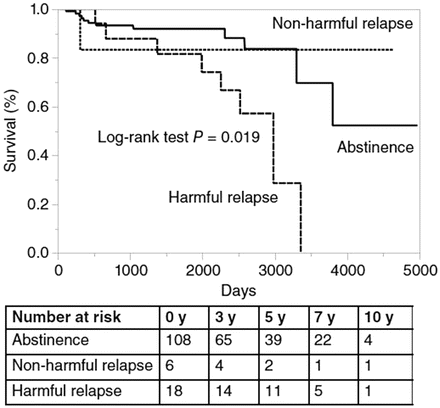Medical factors
Failure of medical therapy
Probability of survival without transplant
MELD score
Pulmonary status
Renal failure
Infection
Surgical factors
Probability of survival with transplant
Age
BMI
Technical complexity (anatomic considerations, prior operations)
Social factors
Family support
Employment
Legal history related to alcohol
Polysubstance use
Insurance status (approval requirements by medical directors)
Contract for rehabilitation
Another consideration of patients who present with decompensated alcoholic cirrhosis and high MELD score is that their disease may not be entirely due to cirrhosis. For patients with alcoholism and obesity , alcoholic cirrhosis can coexist with nonalcoholic steatohepatitis, and leads to a more precipitous clinical deterioration [17]. A patient may have a long-standing history of NASH that has been undiagnosed and can be pushed to fulminant hepatic failure or decompensated cirrhosis by acute drinking episodes. In these cases, a 6-month waiting period may not be warranted if the patient’s decompensation is due to NASH rather than alcoholism.
7.6 Acute Alcoholic Hepatitis
The recent publication of clinical outcomes of liver transplantation for alcoholic hepatitis, who failed medical therapy, has validated the durable survival benefit of transplant compared to medical therapy [18]. This study selected 26 patients (failed prednisolone therapy, and had Lille score >0.80) that were highly selected based on medical and social evaluations and represented less than 2 % of patients evaluated with alcoholic hepatitis. The impressive survival benefit at 6 months for liver transplant (77 %) versus matched controls on continued supportive therapy (23 %, p < 0.001) confirmed the clinical knowledge of the excellent outcomes of transplantation for this disease (Fig. 7.1). The authors reported that with 2 years of follow-up, only 3 of the 26 had recidivism. One stopped with intervention and none had detectable graft dysfunction.


Fig. 7.1
Kaplan–Meier survival of liver transplant versus medical therapy for alcoholic hepatitis. Significant early and durable survival benefit is offered by liver transplantation to patients who do not respond to medical therapy for alcoholic hepatitis. NEJM 2011, 365: 1790–1800
In the most severe cases of alcoholic hepatitis that result in renal failure requiring renal replacement therapy, the results of medical therapy almost universally fail. The near 100 % mortality of these patients further enhances the survival benefit of liver transplantation [19]. In these patients, the theoretical ability to demonstrate a period of sobriety that would reduce recidivism post-transplant is not only unlikely, but would necessitate the additional requirement for combined liver and kidney transplantation. The use of two organs in these patients to achieve limited sobriety pretransplant is challenged by the high probability of renal recovery with early isolated liver transplantation. Taking these organs away from the long list of nearly 100,000 patients awaiting renal transplantation is further challenge to approaches to alcoholic liver disease that come at the cost of concomitant renal failure.
7.7 Clinical Outcomes
The discussion of liver transplantation for alcoholic cirrhosis must be placed in the context for liver transplantation for other diseases. According to the most recent UNOS data, 5-year patient survival and graft survival was 76.5 and 72.8 % for patients transplanted for alcoholic cirrhosis. These outcomes were better than those for hepatitis C, hepatocellular carcinoma, and nonalcoholic steatohepatitis [20]. The improved outcomes have been most consistently demonstrated within the first 5 years after transplant (Fig. 7.2).


Fig. 7.2
Liver allograft and patient survival post-transplant by disease etiology. Liver transplantation for alcoholic liver disease (ALD) and non-alcoholic steatohepatitis (NASH) demonstrate superior graft (a) and patient survival (b) as compared to etiologies of hepatitis C (HCV) and hepatocellular carcinoma (HCC). From Wong RJ et al. Clin Transplant. 2014 Jun;28(6):713–21
Some recent data suggest a poorer outcome beyond 5 years for patients transplanted for alcoholic liver disease [21]. Although these patients had similar rates of graft failures before and after 5-year time periods, the overall long-term survival was worse, but it was not related to recidivism or graft-related issues. The poor long-term survival is likely associated with the medical conditions that may accompany alcohol-induced cirrhosis that require unique attention compared to etiologies for other liver disease. These patients are at increased risks for head and neck, esophageal, and lung malignancies, and require lifelong monitoring because of this overall risk [12]. Reports support that up to 40 % of patients transplanted for alcoholic liver disease will also resume smoking tobacco post-transplant [22]. These patients often resume smoking early post-transplant, and thus increase their risk of cardiovascular and malignant disease. Thus, monitoring and treatment for tobacco dependency is highly relevant in this patient population. Head and neck squamous cell cancers are specifically increased in patients transplanted for alcoholic liver disease and occur in up to 5 % of patients with overall survivals at 1, 3, and 5 years of 74, 47, and 34 % [23]. The risk of head and neck cancer increases incrementally with the addition of tobacco use. Alcoholism treatment both pre- and post-transplant has been centered on psychological and social surveillance and counseling. Efforts should be expanded to encourage tobacco cessation in this susceptible population.
7.8 Recidivism
Liver transplantation in the context of the 6-month rule still is associated with 20–30 % patients returning to significant alcohol consumption [24]. More specific investigations of patterns alcohol use provide greater insight into overall burden and subsequent problem of alcohol consumption post-transplant. Self-reporting surveys of liver transplant patients from Finland demonstrated that overall 43 % of liver transplant recipients transplanted for any cause used alcohol post-transplant and 28 % had consumed within the last month [25]. These rates were similar to liver transplant recipients transplanted for alcoholic liver disease who reported rates of 39 % for any alcohol use and 34 % within the last month. These rates of alcohol use were similar to societal patterns within Finland. Another study from Sweden reported a 33 % rate of recidivism. Recidivism rates were equivalent whether or not the transplant recipient had a 6-month period of sobriety preoperatively. Interestingly, resumption of drinking was not associated with increased mortality or graft loss. Repeat biopsies revealed mild steatosis without recurrence of cirrhosis. Morbidity and mortality was more commonly associated with the development of aerodigestive malignancy [26]. In another study, approximately 25 % of deceased donor transplant recipients acknowledged alcohol relapse with associated laboratory abnormalities, but the laboratory values normalized to pre-relapse values after ceasing alcohol intake [27]. Only one of 16 of these patients demonstrated histologic evidence of toxic liver damage related to alcohol.
Living donor liver transplant recipients demonstrate similar patterns of recidivism. A study of living donor liver transplant recipients from Japan demonstrated an overall relapse rate of 23 % defined by self and physician reporting (see Table 7.2 for summary of recidivism rates). Harmful alcohol use defined as histologic damage, biochemical abnormalities, or mental health consequences was associated with significantly worse outcomes (Fig. 7.3) [28]. Interestingly, non-harmful relapse was not associated with poor outcomes in this study.

Table 7.2
Quoted rates of recidivism post-transplant
Endnote number | Study | Study population | Rate of recidivism post-transplant (%) |
|---|---|---|---|
6 | Berlakovitch | N = 58, Austria | 31 |
9 | Dimartini | N = 167, USA | 42 |
25 | Lim | Meta-analysis | 20–30 |
26 | Koljonen | N = 207, Finland | 39 |
27 | Björnsson | N = 103, Sweden | 33 |
29 | Egawa | N = 195: 187 living donor, 5 deceased donor, 3 domino. Japan | 23 |
32 | Hilke | N = 31, Germany | 32 |

Fig. 7.3
Kaplan–Meier survival after living donor liver transplantation as influenced by alcohol relapse. Post-liver transplant patient survival was significantly worsened in patients with harmful relapse compared to either abstinent or non-harmful relapsing patients. From Egawa H et al. Hepatol Res. 2014 Dec;44(14):E428–36
Monitoring for recidivism can be challenging for the transplant team. Traditional assessments of patient interview and urine or blood screening are most commonly utilized. Risk stratification scoring systems , such as the Alcohol Relapse Risk Assessment have been used as valid predictive tools to identify patients at risk for alcoholism recurrence post-transplantation (Table 7.3) [29]. Nine independent variables are identified to predict post-transplant relapse, with higher scores associated with greater recurrence frequency and intensity. Another scoring system is the High Risk Alcoholism Relapse Scale , which assesses drinking severity pretransplant to determine the risk of relapse post-transplant. Higher scores were associated with greater rates of recidivism (Table 7.4) [30]. Recidivism rates often decrease with time since transplant (see Figs. 7.4, 7.5, and 7.6).
Table 7.3
Multivariate logistic regression model for prediction of relapse to any alcohol use after liver transplant
Predictor variable | Regression coefficient | Odds ratio (95 % CI) | P |
|---|---|---|---|
Presence of hepatocellular carcinoma | −1.89 | 0.15 (0.06, 0.40) | <0.001 |
Tobacco dependence | 2.24 | 2.46 (1.18, 10.65) | 0.01 |
Continued alcohol use after liver disease diagnosis | 1.80 | 1.79 (1.13, 3.27) | <0.001 |
Low motivation for relapse prevention treatment | 1.62 | 1.59 (1.06, 2.41) | 0.02 |
Poor stress management skills | 1.31 | 3.61 (1.09, 14.12) | 0.049 |
Lack of a rehabilitation relationship | 1.67 | 2.09 (1.13, 4.65) | 0.04 |
Limited social supports
Stay updated, free articles. Join our Telegram channel
Full access? Get Clinical Tree
 Get Clinical Tree app for offline access
Get Clinical Tree app for offline access

|


